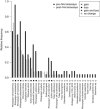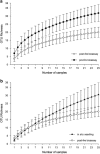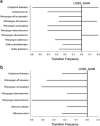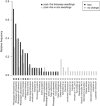Ectomycorrhizal fungal spore bank recovery after a severe forest fire: some like it hot
- PMID: 26473720
- PMCID: PMC5029211
- DOI: 10.1038/ismej.2015.182
Ectomycorrhizal fungal spore bank recovery after a severe forest fire: some like it hot
Abstract
After severe wildfires, pine recovery depends on ectomycorrhizal (ECM) fungal spores surviving and serving as partners for regenerating forest trees. We took advantage of a large, severe natural forest fire that burned our long-term study plots to test the response of ECM fungi to fire. We sampled the ECM spore bank using pine seedling bioassays and high-throughput sequencing before and after the California Rim Fire. We found that ECM spore bank fungi survived the fire and dominated the colonization of in situ and bioassay seedlings, but there were specific fire adapted fungi such as Rhizopogon olivaceotinctus that increased in abundance after the fire. The frequency of ECM fungal species colonizing pre-fire bioassay seedlings, post-fire bioassay seedlings and in situ seedlings were strongly positively correlated. However, fire reduced the ECM spore bank richness by eliminating some of the rare species, and the density of the spore bank was reduced as evidenced by a larger number of soil samples that yielded uncolonized seedlings. Our results show that although there is a reduction in ECM inoculum, the ECM spore bank community largely remains intact, even after a high-intensity fire. We used advanced techniques for data quality control with Illumina and found consistent results among varying methods. Furthermore, simple greenhouse bioassays can be used to determine which fungi will colonize after fires. Similar to plant seed banks, a specific suite of ruderal, spore bank fungi take advantage of open niche space after fires.
Figures







References
-
- Agresti A. (2013) Categorical Data Analysis. John Wiley & Sons: Hoboken, NJ, USA.
-
- Amend AS, Seifert KA, Bruns TD. (2010). Quantifying microbial communities with 454 pyrosequencing: does read abundance count? Mol Ecol 19: 5555–5565. - PubMed
-
- Baar J, Horton TR, Kretzer AM, Bruns TD. (1999). Mycorrhizal colonization of Pinus muricata from resistant propagules after a stand-replacing wildfire. New Phytologist 143: 409–418.
Publication types
MeSH terms
LinkOut - more resources
Full Text Sources
Other Literature Sources

